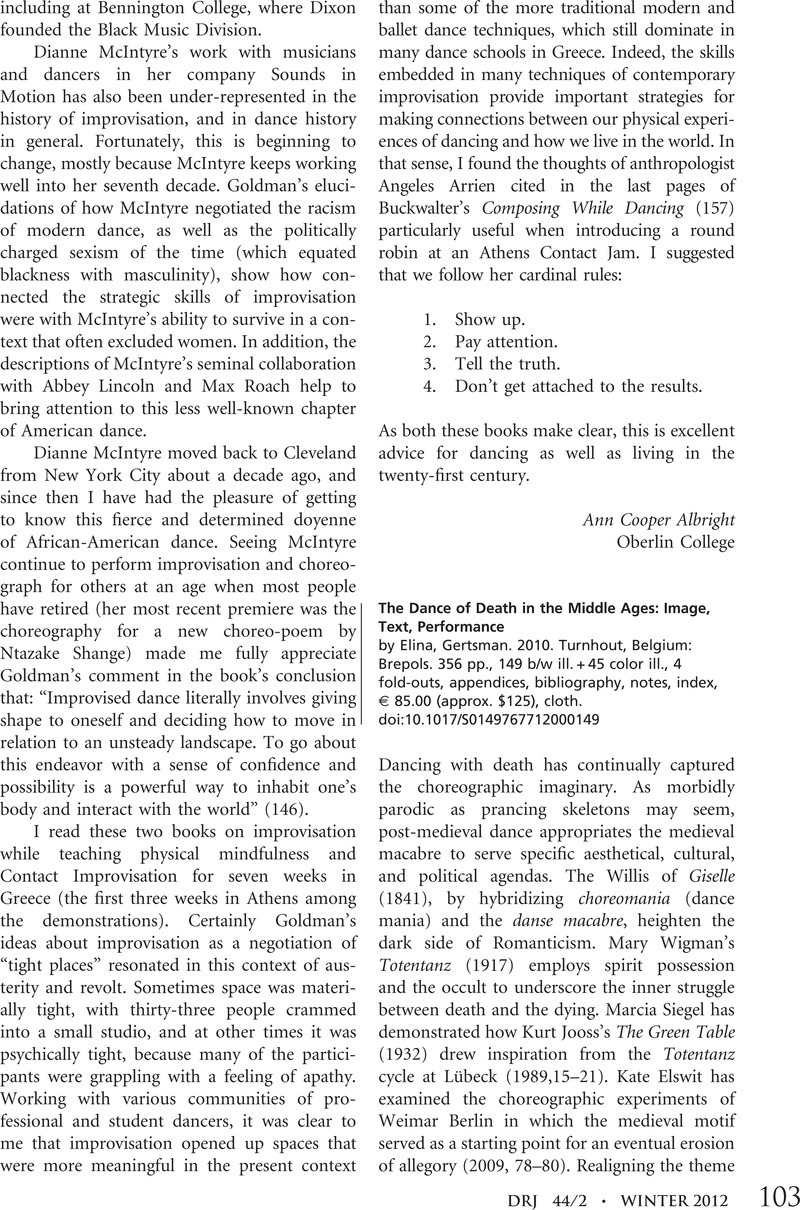No CrossRef data available.
Article contents
The Dance of Death in the Middle Ages: Image, Text, Performance. by Elina Gertsman. 2010. Turnhout, Belgium: Brepols. 356 pp., 149 b/w ill. + 45 color ill., 4 fold-outs, appendices, bibliography, notes, index, € 85.00 (approx. $125), cloth.
Published online by Cambridge University Press: 29 August 2012
Abstract
An abstract is not available for this content so a preview has been provided. Please use the Get access link above for information on how to access this content.

- Type
- Book Reviews
- Information
- Copyright
- Copyright © Congress on Research in Dance 2012
References
Works Cited
Böhme, Franz Magnus. 1886. Geschichte des Tanzes in Deutschland: Beitrag zur Deutschen Sitten, Literatur, und Musikgeschichte. Leipzig, Germany: Breitkopf und Härtel.Google Scholar
Clark, James M. 1950. The Dance of Death in the Middle Ages and the Renaissance. Glasgow: Jackson, Son and Company.Google Scholar
Cohn, Samuel K. 2002. The Black Death Transformed: Disease and Culture in Early Renaissance Europe. London: Arnold.Google Scholar
Cossachi, Stephan. 1965. Makabertanz: Der Totantanz in Kunst, Poesie, und Brachtum des Mittelalters. Meisenham am Glam, Germany: A. Hain.Google Scholar
Elswit, Kate. 2009. “Berlin … Your Dance Partner is Death.” TDR: The Drama Review 53(1): 73–92.CrossRefGoogle Scholar
Franko, Mark. 1995. “Mimique.” In Bodies of the Text: Dance as Theory, Literature as Dance, edited by Goellner, Ellen W. and Murphy, Jacqueline Shea, 205–16. New Brunswick, NJ: Rutgers University Press.Google Scholar
Gertsman, Elina. 2003. “The Dance of Death in Reval (Tallinn): The Preacher and His Audience.” Gesta 62(2): 143–59.Google Scholar
Gertsman, Elina. 2005. “Visual Space and the Practice of Viewing: The Dance of Death at Meslay-le-Grenet.” Religion and the Arts 9(1–2): 1–37.CrossRefGoogle Scholar
Gertsman, Elina. 2006. “Pleyinge and Peyntinge: Performing the Dance of Death.” Studies in Iconography 27: 1–43.Google Scholar
Gertsman, Elina. 2008. “Death and the Miniaturized City: Nostalgia, Authority, Idyll.” Essays in Medieval Studies 24(1): 43–52.CrossRefGoogle Scholar
Gertsman, Elina. 2010. “The Facial Gesture: (Mis)Reading Emotion in Gothic Art.” Journal of Medieval Religious Cultures 36: 28–46.CrossRefGoogle Scholar
Großkreutz, Peter. 2003. “Der Tanz im Totantanz: ‘And in Most of Them Dancing is Not Shown Either.’” Gutenberg-Jahrbuch 78: 67–73.Google Scholar
Hammerstein, Reinhold. 1980. Tanz und Musik des Todes: Die Mittelalterlichen Totentänze und Ihr Nachleben. Bern, Germany: A. Francke.Google Scholar
Isar, Nicoletta. 2003. “The Dance of Adam: Reconstructing the Byzantine Xopóc.” Byzantinoslavica 61: 179–204.Google Scholar
Isar, Nicoletta. 2005. “ΧΟΡÓΣ: Dancing into the Sacred Space of the Chora, an Inquiry into the Character of Dance from the Chora.” Byzantion 75: 199–224.Google Scholar
Isar, Nicoletta. 2006. “Chorography (Chôra, Chorós)—A Performative Paradigm of Creation of Sacred Space in Byzantium.” In Hierotropy: The Creation of Sacred Spaces in Byzantium and Medieval Russia, edited by Lidov, Alexei, 59–90. Moscow: Indrik.Google Scholar
Lepecki, André. 2004. “Inscribing Dance.” In On the Presence of the Body: Essays on Dance and Performance Theory, edited by Lepecki, André, 124–39. Middletown, CT: Wesleyan University Press.Google Scholar
Lidov, Alexei. 2006. “Hierotropy: The Creation of Sacred Spaces as a Form of Creativity and Subject of Cultural History.” In The Creation of Sacred Spaces in Byzantium, edited by Lidov, Alexei, 32–57. Moscow: Indrik.Google Scholar
Noland, Carrie. 2009. Agency and Embodiment: Performing Gestures/Producing Culture. Cambridge, MA: Harvard University Press.CrossRefGoogle Scholar
Oosterwijk, Sophie. 2008. “Of Dead Kings, Dukes, and Constables: The Historical Context of the Danse Macabre in Late Medieval Paris.” British Archaeological Association 161: 131–62.CrossRefGoogle Scholar
Parmentier, Richard J. 1994. Signs in Society: Studies in Semiotic Anthropology. Bloomington, IN: Indiana University Press.Google Scholar
Parmentier, Richard J., and Mertz, Elizabeth (eds.). 1985. Semiotic Mediation: Sociocultural and Psychological Perspectives. Orlando, FL: Academic Press.Google Scholar
Pentcheva, Bissera. 2006. “The Performative Icon.” Art Bulletin 88(4): 631–55.CrossRefGoogle Scholar
Pentcheva, Bissera. 2009. “Moving Eyes: Surface and Shadow in the By zantine Mixed-Media ReliefIcon.” Res: Anthropology and Aesthetics. 55/56: 222–32Google Scholar
Pentcheva, Bissera. 2010. The Sensual Icon: Space, Ritual, and the Senses in Byzantium. University Park, PA: Pennsylvania State University Press.Google Scholar
Siegel, Marcia B. 1972. At The Vanishing Point: A Critic Looks at Dance. New York: Saturday Review Press.Google Scholar
Pentcheva, Bissera. 1989. “The Green Table: Sources of a Classic.” Dance Research Journal 21(1): 15–21.Google Scholar
Taylor, Jane H. M. 1989a. “Danse Macabre and Bande Dessinée: A Question of Reading.” Forum for Modern Language Studies 25(4): 356–69.CrossRefGoogle Scholar
Taylor, Jane H. M.. 1989b. “Poésie et Prédication: La Fonction du Discours Proverbial dans la Danse macabre.” Medioevo Romanzo 14(2): 215–26.Google Scholar




